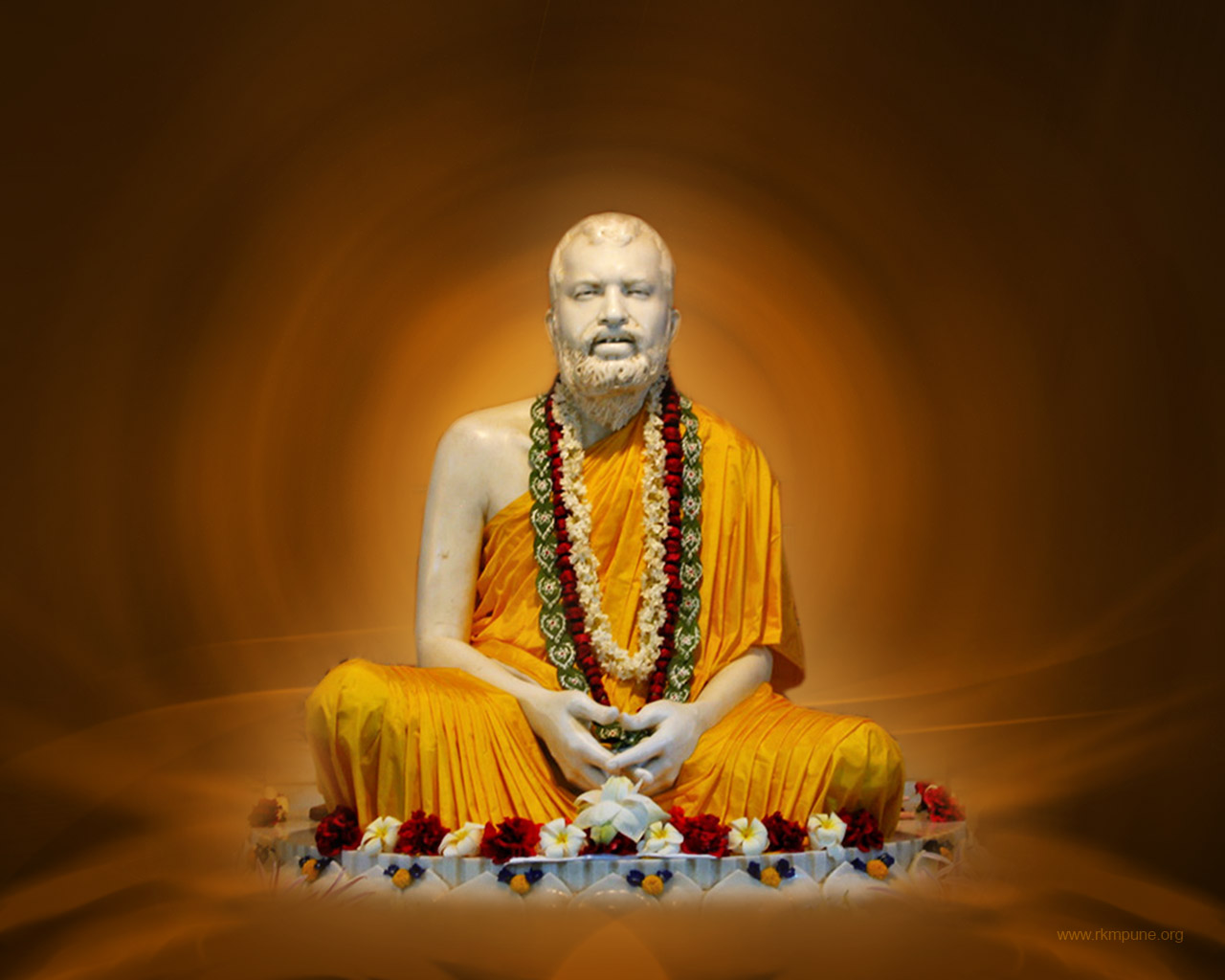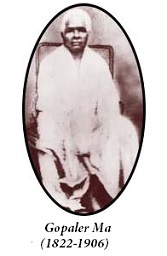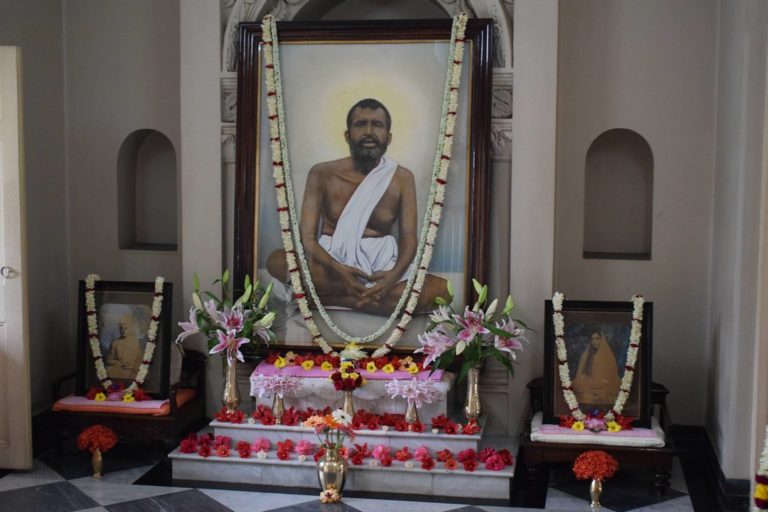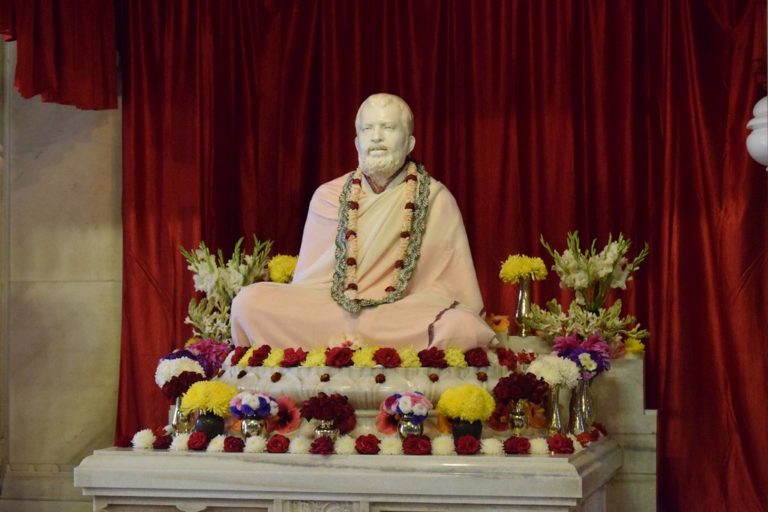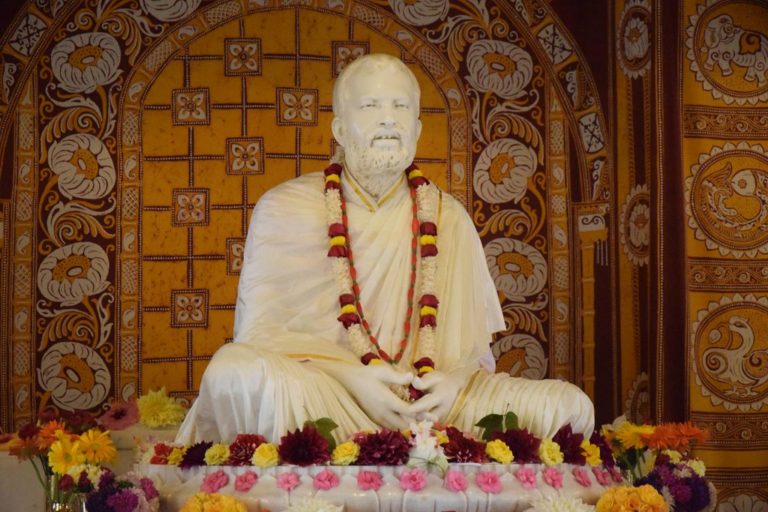Significance of Love of God
Bhakti means love of God.
The term Bhakti is derived from the Samskrit root bhaj which means ‘serving with love’ (bhaj sevayam). Bhakti hence means loving service. It is the love towards God and serving Him with affection and respect which is the true meaning of real Bhakti.
Sri Ramakrishna says that God especially relishes the Bhakti—‘loving service’—of the poor and the lowly. In the Mahabharata it is narrated how Sri Krishna accepted the simple hospitality of the poor Vidura and not of the lavish one offered by Duryodhana who was the king. Indeed, God is fond of his devotees. Sri Ramakrishna says in his Gospel,1
God very much relishes the bhakti of the poor and the lowly, just as the cow relishes fodder mixed with oil-cake. King Duryodhana showed Krishna the splendour of his wealth and riches, but Krishna accepted the hospitality of the poor Vidura. God is fond of His devotees. He runs after the devotee as the cow after the calf.
Bhakti is the one essential thing for attaining the highest spiritual enlightenment which means experiencing the Eternal and Infinite Love, Life and Joy. To love God, there is no necessity to know the glories or powers of God. Human life is meant to realise God and not to be wasted in trying to know the ways of God or to judge Him. Infinite are His ways of managing His limitless creation; how can our puny minds comprehend His ways? Can a baby understand the Einstein’s Theory of Relativity? We are all babies in the infinite and complex world of creation and how it works. We are too small to understand it. Nor, says Sri Ramakrishna, is there any practical use of knowing all this stuff. Spiritual experience is all that matters.
Sri Ramakrishna met many scholarly people who tried to ‘judge God’ and say that God was not right or proper. Sri Ramakrishna advised them that it was a futile exercise because it did not help them in the progress of their spiritual life of Bhakti. First of all our common sense says that one who judges others must have superior knowledge, power, etc., than the one whom he judges. Can anyone, even the greatest intellect or moral person, claim to be more intelligent or moral than God? In Sri Ramakrishna’s language can a vessel of one litre capacity hold four litres of liquid?
Once Iswarchandra Vidyasagar, a legend of Bengal in vast learning, philanthropy and strong character, complained that God was inactive and did not prevent the massacre of hundred thousands of prisoners of war by Chengis Khan because he could neither feed nor release them! Sri Ramakrishna when he heard the complaint of Vidyasagar commented thus, ‘Can one understand God’s motive? The aim of human life is to attain Bhakti. We have come here to eat mangos (i.e. to attain the infinite joy of Mukti), not to count branches and leaves on the tree, i.e., waste our time and energy in futile reasoning, etc.
In order to attain that one has to follow what is called ‘Yoga’, the path of inner growth. While Sri Ramakrishna describes all the four Yogas—Karma, Jnana, Dhyana and Bhakti—he affirms that Bhakti yoga is the one best suited for this age of ours—the Kaliyuga. And that too the Bhakti yoga as advocated by sage Narada.
The Bhakti According to Narada
It is believed that Narada, the celestial sage mentioned in the Hindu scriptures, was entrusted the task of spreading Bhakti among one and all. The Narada Bhakti Sutras attributed to him describe various aspects of developing Bhakti. The Bhakti according to Narada consists of singing the Name and glories of God and praying to Him for knowledge, devotion and His vision.
Sri Ramakrishna asked2 a devotee to pray to God thus:
May my actions, O Divine Mother, be fewer every day till I attain Thee. May I perform, without attachment to the results, only what action is absolutely necessary for me. May I have great love for Thee as I go on with my few duties. May I not entangle myself in new work so long as I do not realize Thee. But I shall perform it if I receive Thy command. Otherwise not.
This is the core of Narada’s way of Bhakti—to seek unconditional love for God.
The Formal Bhakti
The beginner’s Bhakti is rather elementary. It consists of doing some chanting, Japa, worship, sacrifice, and so on for sometime. And when this does not seem to bear any fruits, the beginner gives up in disgust. He is impatient and fickle-minded. On the other hand, the real devotee is like a seasoned farmer who will not give up farming even if the rains fail year after year. Sri Ramakrishna says,3
First one has to follow the rules of worship and formal adoration of God. It is called Vaidhi Bhakti. If one follows it sincerely, it leads to Raga Bhakti, passionate love of God.
Growing in Bhakti
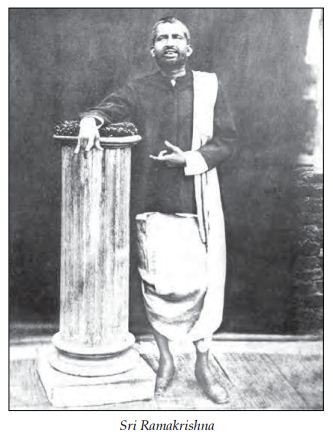
Sri Ramakrishna further says that as you develop love for God, your worldly duties become fewer and fewer and after Godrealisation they completely drop away. He said,4
When the fruit appears the blossom drops off. Love of God is the fruit, and rituals are the blossom. When the daughter-in-law of the house becomes pregnant, she cannot do much work. Her mother-in-law gradually lessens her duties in the house. When her time arrives she does practically nothing. And after the child is born her only work is to play with it. She doesn’t do any household duties at all.
God can be seen if one takes to the company of the holy people. Who are holy people? Those people who hold God realization as the goal of their lives and who do all other duties of the world to please God alone. They do not have any other motive. One should seek company of such holy people.
One should also constantly pray to God for keeping one away from temptations of sense pleasures, greed of wealth, name, fame and power. One should find a Guru as a guide and follow his instructions. Then one can see God.
In any spiritual path, an aspirant is tormented by the thoughts of the mistakes or sins one has committed, knowingly and unknowingly. Some religious people advocate that ‘confession’ before some religious person can remove the sins. But Sri Ramakrishna advocates that all sins go away by chanting God’s name. He says that one should firmly say this:5
One should have such burning faith in God that one can say: ‘What? I have repeated the name of God, and can sin still cling to me? How can I be a sinner any more? How can I be in bondage any more?’
If a man repeats the name of God, his body, mind, and everything become pure. Why should one talk only about sin and hell, and such things? Say but once, ‘O Lord, I have undoubtedly done wicked things, but I won’t repeat them.’ And have faith in His name.
Indeed, we must be able to tell God who is our own father and mother, ‘O Lord, I have no doubt committed sins but I won’t repeat them.’ This is the way of not getting tormented by them and be free of guilt feelings forever.
Sri Ramakrishna further tells that one should approach a holy man, accept him as his Guru and follow the instructions he receives from him. Sri Ramakrishna says,6
Everybody will surely be liberated. But one should follow the instructions of the guru; if one follows a devious path, one will suffer in trying to retrace one’s steps. It takes a long time to achieve liberation. A man may fail to obtain it in this life.
Three Types of Bhakti
Sri Ramakrishna speaks of Sattvik, Rajasik and Tamasik Bhakti. These three are the Gunas, the basic qualities, with which the whole creation is made of Sattva stands for purity and knowledge, Rajas for activity and Tamas for dullness and inactivity.
A Sattvik devotee, the one who has more Sattva in his nature, practices Bhakti in a very simple way. When he worships God, he does so without any show and fanfare. He uses simple things while worshiping his chosen form of God. The one who is of Rajasic nature makes a show of his Japamala, wears a silken cloth and tries to impress with external marks and so on.
The one who is of Tamasic nature shows a fiery spirit in his prayers to God. Sri Ramakrishna says,7
A man endowed with tamasic bhakti has burning faith. Such a devotee literally extorts boons from God, even as a robber falls upon a man and plunders his money. ‘Bind! Beat! Kill!’—that is his way, the way of the dacoits.
We can see here Sri Ramakrishna’s appreciation of the ‘dynamism’ of the Tamasic devotee. In another place also he actually praises this good side of a Tamasic devotee!
The Single-minded Bhakti
Another aspect of Bhakti is the singlemindedness. There are some devotees who are attached to a single aspect of God although they know that God has other aspects. Sri Ramakrishna mentions the case of Hanuman who would not see God in any form other than Rama. So also was Vibhishana who refused to salute Krishna in the Rajasuya sacrifice mentioned in the epic Mahabharata. Sri Ramakrishna narrates:8
Once the Pandava brothers performed the Rajasuya sacrifice. All the kings placed Yudhisthira on the royal throne and bowed low before him in homage. But Vibhishana, the King of Ceylon, said, ‘I bow down to Narayana and to none else.’ At these words the Lord Krishna bowed down to Yudhisthira. Only then did Vibhishana prostrate himself, crown and all, before him.
So were the Gopis of Vrindaban who wanted the young cowherd form of Krishna and would not even look at Krishna in the royal attire wearing crown in Mathura!
Sri Ramakrishna compares this type of Bhakti to the attitude of a wife toward her husband. He says,9
Do you know what devotion to one ideal is like? It is like the attitude of a daughter-in-law in the family. She serves all the members of the family—her brothers-in-law, father-in-law, husband, and so forth—bringing them water to wash their feet, fetching their towels, arranging their seats, and the like; but with her husband she has a special relationship.
In social life also we see we love in a general way all but we shower love on some in a special way.
Sri Ramakrishna makes a special reference to the love of a perfect lover of God. He says,10
The Paramahamsa realizes that all these—good and bad, virtue and vice, real and unreal—are only the glories of God’s maya. But these are very deep thoughts. One realizing this cannot keep an organization together or anything like that.
Further Glimpses of Bhakti
Bhakti is a passionate pursuit of an ideal God. Human nature sometimes cannot keep up the same enthusiasm and may get distracted. Then they may feel that they do not have enough time for practicing Bhakti. Sri Ramakrishna comes to our rescue when he says, ‘Devotion is well suited to Kaliyuga.’ This means one should constantly chant the name and glories of God. Sri Ramakrishna says:11
If a devotee prays to God with real longing, God cannot help revealing Himself to him. . . . [Bhakti means] to adore God with body, mind, and words. ‘With body’ means to serve and worship God with one’s hands, go to holy places with one’s feet, hear the chanting of the name and glories of God with one’s ears, and behold the divine image with one’s eyes. ‘With mind’ means to contemplate and meditate on God constantly and to remember and think of His lila. ‘With words’ means to sing hymns to Him and chant His name and glories. . . . let those who have no leisure worship God at least morning and evening by whole-heartedly chanting His name and clapping their hands.
When Sri Ramakrishna wanted to practice Vedanta (Jnana yoga) under his Vedanta Guru Sri Totapuri, his Tantrik Guru, Bhairavi Brahmani dissuaded him from doing so. She thought that the Bhakti to Divine Mother she had taught Sri Ramakrishna would be destroyed by the Jnana of Guru Totapuri. Indeed, this is what many thought until Sri Ramakrishna appeared on the spiritual scene. Sri Ramakrishna practiced Jnana under Totapuri successfully and then said ‘One can attain the knowledge of Brahman too by following the path of Bhakti. God is all powerful. He may give his devotee Brahmajnana also if he so wills. But the devotee generally does not seek knowledge of the absolute. He would rather have the consciousness that God is the Divine Mother and he the child.’
Sri Ramakrishna demonstrated this in his life. How many times he would go into deep Samadhi, i.e. experience of the oneness with Brahman, while listening to devotional songs on Rama or Shiva!
Once Sri Ramakrishna was returning to his room from the pine grove. He saw hypocrite Hazra telling beads. He said to the Divine Mother, ‘Mother, how smallminded fellow he is. He lives here [with Sri Ramakrishna] and still he practices Japa with a rosary. Whoever comes here will have his spiritual consciousness awakened all at once! He won’t have to bother much about Japa!’
Conclusion
We have numerous Bhaktas in our Indian spiritual history who have practised and attained to perfection by the path of Bhakti as discussed above. Yet in the modern times, Sri Ramakrishna has left the example of his life and the lives of a galaxy of his disciples—both monastic and house-holders—who attained to highest spiritual illumination through Bhakti. We have amidst them unlettered ones, aged ones, bereaved ones who lost their near and dear people, helpless women, child widows—all of them attained spiritual fulfilment.
Sri Ramakrishna taught them, in general, the path of ‘Servant-Master’ relationship (dasya) with God. He also exhorted them to consider and call on God as ‘Mother’ which would yield success easily. To people who felt very helpless such as Girish Chandra Ghosh (who was given to drinking and was a womaniser), or fallen women like Tara Sundari, Vinodini who were actresses in drama companies, Sri Ramakrishna prescribed ‘the path of self-surrender’ to God called Saranagati. These aspirants with the strength of their fiery faith and resignation to Sri Ramakrishna attained to unimaginable heights of moral perfection and spiritual enlightenment!
Thus Sri Ramakrishna, the greatest of the Incarnations (avataravarishtha), as called by Swami Vivekananda, demonstrated the truth of Bhagavad Gita that even the ‘worst of sinners’ (suduracharo) can attain to mukti by surrendering themselves to God.
He has also demonstrated the truth of Bhagavatam that one who has neither full dispassion nor too much attachment to worldly life (and its activities) but has developed a faith in My (God’s) life and works, can attain spiritual enlightenment through Bhakti:12
यदृच्छया मत् कथादौ जातश्रद्धस्तु यः पुमान्
न निर्विण्णो नाति सक्तो भक्ति योगोस्य सिद्धिदः।।
Lastly but not the least, comes the great teaching of Sri Ramakrishna that it is the duty of every man to serve God in man. He taught that by helping the poor and the needy, it is the helper that is benefited because he is rendering worship to the God in the poor and needy. He thus develops more and more unselfishness and love of God through such an action and eventually realises God. He thus attains to the same goal which a Bhakta would attain.
References
1. Gospel, p. 157
2. Ibid, p.469
3. Ibid, p. 628
4. Ibid, p. 465
5. Ibid, 138
6. Ibid, p.98
7. Ibid, p.147
8. Ibid. p. 228
9. Ibid, p.229
10. Ibid, p. 250
11. Ibid, p.680
12. Bhagavatam, 11-20-8
Source : Vedanta Kesari, December, 2015
